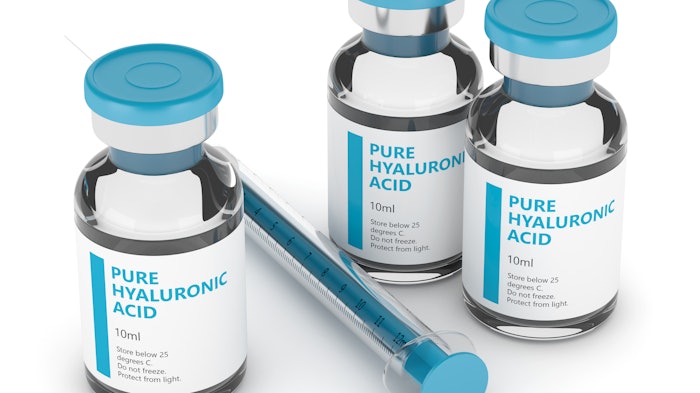
Hyaluronic acid (HA) has become a well discussed ingredient in the industry, with many boasting about it's different uses and benefits to the skin. Well known for its ability to hold 1000 times its weight in water, HA is a staple skin care ingredient that is here to stay. To learn more about the different uses of hyaluronic acid and how it differs when used topically versus for injectables, MedEsthetics interviewed James Beckman, MD, board certified plastic surgeon and founder of Therapon Skin Health.
MedEsthetics (ME): What is hyaluronic acid?

ME: What does hyaluronic acid do?
JB: HA attracts over one thousand times its own weight in water and can bind this water to itself. Shorter chains of HA are water soluble and are used in skin care product formulations use topically on skin. These shorter chain molecules of HA can easily penetrate down into the dermis and draw moisture to restore softness, smoothness and pliability to skin. The larger chain forms of HA particles are metabolized slowly by the body due to having a “solid particle” property. Because of this, HA is often used in injectable filler products to fill in skin wrinkles or depressed areas.
ME: What is the difference between injectable, supplemental and topical hyaluronic acid?
JB: Injectable HA is comprised of the shorter chain molecule length as they are usually in a liquid form of the substance. Supplemental refers to edible HA forms of the substance that can be easily digested into the very short molecule chains useful in replenishing body stores for joint fluid restoration and even skin structure. Topical HA means forms that may be easily absorbed when applied to the surface of skin itself.
ME: What skin concerns are hyaluronic acid ideal for?
JB: Injectable forms are used to “plump up” the actual deeper wrinkles of the face related to aging or sun damage. HA also can be used to replace volume in areas of loss of soft tissue fatty substance that may be causing hollowed-out or depressed facial features. Topical use is usually delivered via formulations of skin care products developed to minimize fine wrinkles, dryness or leathery pliability conditions of the facial skin.
ME: What are the differences in the size molecules in terms of penetration and hydration?
JB: HA will attract water molecules wherever located in or on the skin. The key is to get the HA into the place in the skin where they can attract moisture where it is deficient. Molecule sizes are critical to whether topical applications can be absorbed into deeper skin layers. Small molecules are shorter and can more easily penetrate the skin through the protective cell layers of the epidermal outer layer. Obviously, the larger sized injectable forms are used as mechanical fillers to fill in below wrinkles to “lift” the wrinkle trough and eradicate the wrinkle appearance.
ME: How do they get the HA molecules to penetrate skin?
JB: Topical penetration is solely dependent on small HA molecule size ranges and skin that has been cleansed to prepare for topical absorption of skin care ingredients. Obviously, the more deeply used injectable forms are in liquid suspension formula using needle and syringe on numbed skin.
ME: What treatments pair well with the use of hyaluronic acid?
JB: Use of HA is simply using a “tool” available along with other treatment tools or devices that treat wrinkles, dryness, or other texture conditions. However, injectable forms should not be used at the same time as deeper chemical skin peels, laser resurfacing or other procedures that require significant skin healing time. Those invasive or injurious procedures may be done first then allowed to heal and then injectable HA or topical skin care regimen products may be safely used if needed.











